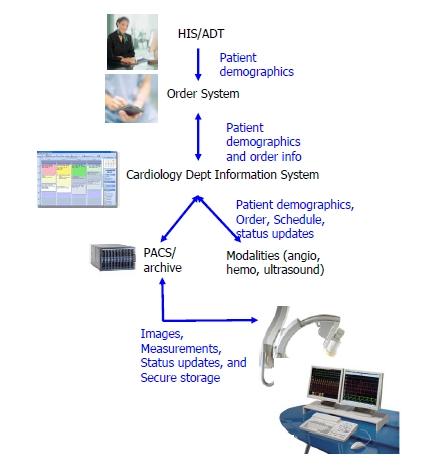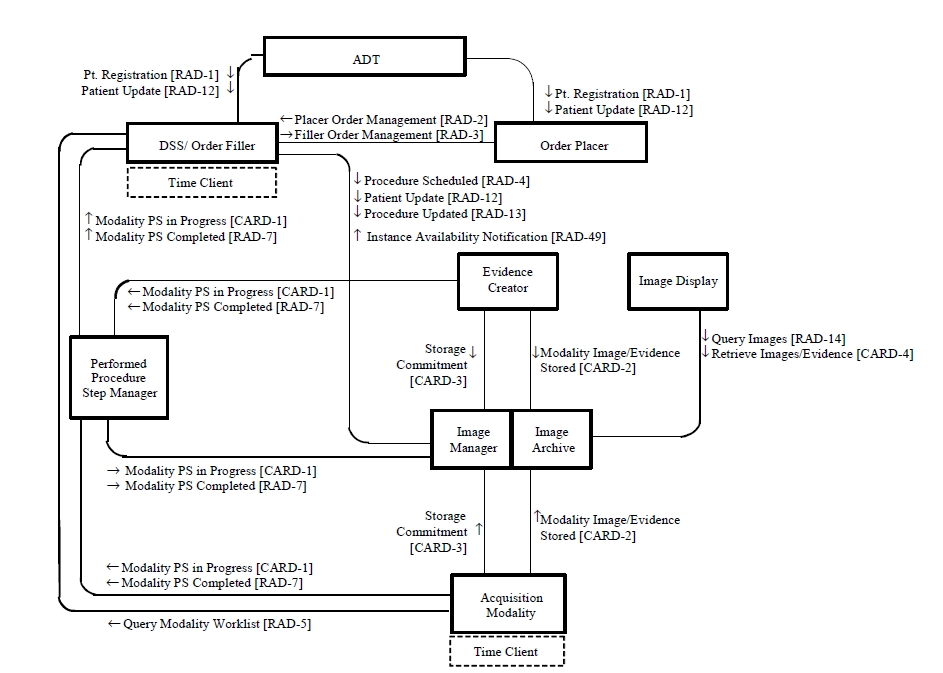Cardiac Cath Workflow
This profile integrates ordering, scheduling, imaging acquisition, storage and viewing for Cardiac Catheterization procedures
Summary
Cardiac Catheterization is complex, especially from a workflow perspective. Evidence-gathering activities may begin before an order is placed; in fact, orders are often not created for a cardiac catheterization procedure due to its frequent emergency nature. There may be a variety of imaging, measurement, and reporting systems that need to coordinate to use the same patient identifier, and to assure that the evidence produced is all associated with the same procedure. Further, the procedure itself may include both diagnostic and interventional or therapeutic aspects, and may extend over a long time period (several hours).
The Cardiac Catheterization Workflow Integration Profile establishes the continuity and integrity of basic patient data in the context of the cardiac catheterization procedure. This profile deals specifically with consistent handling of patient identifiers and demographic data, including that of emergency patient presentation where the actual patient identity may not be established until after the beginning of the procedure, or even a significant time after the completion of the procedure. It also specifies the scheduling and coordination of procedure data across a variety of imaging, measurement, and analysis systems, and its reliable storage in an archive from where it is available to support subsequent workflow steps, such as reporting. It also provides central coordination of the completion status of steps of a potentially multi-phase (diagnostic and interventional) procedure.
Benefits
Cardiologists
Patient care is improved and cardiologists’ time is saved by:
- Making sure the patient is cared for immediately without concern for completing the proper paperwork first
- Reducing delays in charge posting
- Automatically synchronizing time on all systems within a cath lab so that data can be time tagged to at least 1/10th second accuracy, so that simultaneous events recorded on different systems can be identified
- Providing cath measurement and hemodynamic procedure log interoperability – complete the preliminary cath measurements on a workstation or transfer the procedure log as structured data to the reporting workstation for the final report
Cardiology Administrators and Technologists
Cath lab workflow is improved and time is saved by:
- Reducing time and errors from entering data into multiple systems in the cath lab
- Assuring correct patient demographics and procedure code information
- Automating the correction of demographics in cases such as patient identified mid- or post-procedure (reduces or negates the need to a person to “fix” studies and data)
- Maintaining the status of the procedures real-time so that the cath lab flow manager can better utilize the facilities
- Accurately identifying data to facilitate data collection later (e.g., registries or outcomes analysis)
- Managing and simplifying RFP’s and purchases
- Allowing selection of the “best solutions” from multiple vendors and reducing vendor integration issues, rather than the restriction of a single vendor all-encompassing solution
Cardiology IT Staff
Other IT projects can come to fruition when time is saved in the cath lab by:
- Automatically assuring that all images are securely stored to the archive prior to deletion at the angio system
- Avoiding the implementation and maintenance costs for “one-off” integration interfaces to each device
- Ensuring proper functioning of a multi-vendor environment
- Reducing “switching costs” when new equipment is purchased
Patient
The patient also benefits from systems integration in the cath lab by:
- Removing the need to wait while demographics are entered into the various cath lab systems and old reports are pulled.
- Enabling better patient care because the interpreting physician can more accurately assess interim changes.
- Providing cath reports more readily to other care team members within and outside a hospital or office network.
Details
The Scheduled Workflow (SWF) Integration Profile:
- Establishes the continuity and integrity of basic departmental imaging data by profiling specific usage of HL7 messaging across multiple systems including: Patient registration (ADT), Order Placing (CPOE) and Order SCheduling (RIS) systems.
- Bridges the gap between HL7-based systems (like RIS) and DICOM-based systems (like acquisition modalities and PACS) within the radiology department by specifying the semantic mappings between messages.
- Maintains the consistency of patient demographic and ordering information across multiple systems by making that information available to image acquisition modalities via the DICOM Modality Worklist (MWL) Service.
- Ensures that acquired images are not inadvertently lost by specifying that the DICOM Storage Commitment Service is used to transfer the custodianship of images from the modality to the PACS.
- Ensures that the status of acquisition workflow steps are known throughout the department by specifying the use of the DICOM Modality Performed Procedure Step (MPPS) Service to convey that status from the modality to the RIS and the PACS.
Systems Affected
Systems involved in this profile are:
- Enterprise-wide information systems that manage patient registration and services ordering (i.e., admit-discharge-transfer (ADT)/registration system and hospital information system (HIS ))
- Cardiology information systems that manage department scheduling
- Image management/archiving systems (i.e., picture archiving and communication system (PACS))
- Acquisition modalities
Actors & Transactions:
Specification
Profile Status: Final Text
Documents:
IHE Cardiology Technical Framework:
Underlying Standards:
See Also
Related Profiles
- Echocardiography Workflow [ECHO] - uses many of the mechanisms of SWF to integrate ordering, scheduling, imaging acquisition, storage and viewing for digital echocardiography
- Evidence Documents [ED] specifies how data objects such as digital measurements are created, exchanged, and used.
This page is based on the Profile Template

